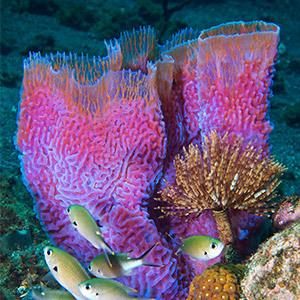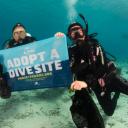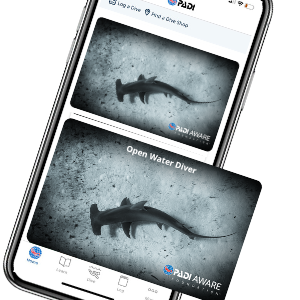About the Course
Learn how to lead underwater tours, assist with scuba classes and inspire others to care about the ocean. Hone your skills and be the diver everyone admires.
PADI Divemaster is the most popular and most recognized professional scuba certification in the world. PADI Divemasters enjoy abundant career opportunities, get paid to scuba dive and share their love for the ocean.
Take This Course If You Want to
Learn How to
Are You Ready To Start PADI Divemaster?
Before purchasing the eLearning course, confirm you meet the course prerequisites and contact your preferred PADI Dive Center or Resort to confirm course availability and scheduling.

1
PADI eLearning®
Interactive lessons cover divemaster-led programs and activities, diver safety and risk management, the aquatic environment and more. Study online or offline using a computer or mobile device. Connect with your instructor whenever you have a question.
Additional training materials are required. Please contact your dive shop or instructor for pricing.
- eLearning time commitment: 8-12 hours

2
With Your Instructor
Gain practical experience giving dive briefings, assisting with classes and leading underwater tours. Learn how to anticipate problems and provide assistance, create an Emergency Assistance Plan and improve your navigation and problem-solving skills through practical workshops.
- Prerequisites: PADI Rescue Diver certification (or qualifying certification); completion of Emergency First Response® Primary and Secondary Care training (or qualifying training) within 24 months; minimum 40 logged dives; medically evaluated and cleared for diving by a physician within 12 months.
- Total time commitment: Varies, contact dive shop
- Minimum age: 18 (15 for Junior Divemaster)
The PADI Difference
For over 50 years, PADI has undeniably been the Way the World Learns to Dive®, setting the standard for the highest quality dive training, underwater safety and conservation initiatives while evolving the sport of diving into a passionate lifestyle.
30,000,000+
(and counting) PADI certified divers to date!
6,600
PADI dive centers and resorts across the globe
128,000
PADI Professional members worldwide
More Info
Scuba diving requires a minimum level of health and fitness. Chronic health conditions, certain medications and/or recent surgery may require you to get written approval from a physician before diving.
Avoid disappointment, download and review the Diver Medical form to ensure you won’t need a physician’s approval to dive before enrolling in a scuba course. Instructors, divemasters and dive shop staff are not physicians and should not be asked for medical advice; only medical professionals can give medical clearance to dive.
If you (or your physician) have questions about medical fitness to dive, contact the experts at Divers Alert Network (DAN).
Minimum Age: 18*
Course prerequisites:
- PADI Rescue Diver certification (or qualifying certification)
- Emergency First Response Primary and Secondary Care training (or qualifying training) within 24 months
- 40 logged dives
- Medically evaluated and cleared for diving by a physician within the past 12 months
* Divers who are younger than 18 but at least 15 may enroll in the PADI Junior Divemaster program.
Junior Divemaster is a sub-set of the PADI Divemaster course. Junior Divemaster candidates may complete a significant portion of the divemaster course, but additional training is required when the Junior Divemaster turns 18.
Junior Divemaster program prerequisites:
- PADI Advanced Open Water Diver and PADI Rescue Diver diver certifications
- 20 logged dives
- Medical clearance to dive
For more information on the Junior Divemaster program, contact a PADI Dive Center, Resort or Instructor.
You can become a divemaster close to home or while traveling abroad. It’s important to contact your preferred PADI Dive Center or Resort before purchasing Divemaster eLearning to confirm the course availability, determine if the course schedule meets your needs and learn about additional fees.
Q. How long does it take to become a divemaster?
A. If you’re at least 18 years old and meet the prerequisites listed above, it’s possible to become a PADI Divemaster in two very intense weeks. Most divemaster candidates complete their training over three weeks to six months.
Contact your preferred PADI Dive Center, Resort or Instructor to learn more about scheduling and availability.
Q. What are the PADI Divemaster swim test requirements?
A. There are three swimming assessments and one treading water exercise. Accommodations can be made for candidates with physical impairments.
- Swim 400 metres/yards nonstop without swimming aids. Use any stroke or combination of strokes.
- Swim 800 metres/yards face down – nonstop – using mask, snorkel and fins only. Use of arms or flotation aids is not permitted unless the candidate has a physical impairment.Tow or push a diver for 100 metres/yards nonstop, at the surface, without assistance. Both divers wear full scuba equipment.
- Tread water, drown-proof, bob or float using no aids and wearing only a swimsuit for 15 minutes. Hold hands (not arms) out of the water for the last two minutes. Candidates with a physical impairment that makes it difficult or impossible to hold their hands out of the water may skip the hand-raising challenge with no reduction in score.
Q. How many dives are required to become a divemaster?
To become a certified divemaster you need at least 60 logged dives. Only 40 dives are required to begin divemaster training. The number of dives you’ll make during the course varies.
Q. What are divemasters allowed to do?
A. PADI Divemasters can:
- Assist certified PADI Instructors with training and non-training diving activities
- Guide certified scuba divers on fun dives
- Lead Discover Local Diving programs
- Assist with Discover Scuba Diving® programs
- Conduct the PADI ReActivate® scuba refresher program
- Teach Discover Snorkeling and PADI Advanced Snorkeler courses
- Organize and lead conservation activities
With additional training, divemasters can also work as equipment repair techs, deck hands, become boat captains and more. Read more about what divemasters can do.
Q. Can divemasters teach?
A. Upon certification, PADI Divemasters can:
- Conduct the PADI ReActivate® scuba refresher program
- Teach Discover Snorkeling and PADI Advanced Snorkeler courses
With additional training, PADI Divemasters can conduct Discover Scuba Diving (DSD®) experiences in a pool or confined water. They may also lead divers who have successfully completed a DSD experience on guided dives after participants have made their first dive with an instructor. The DSD participants must be under an instructor’s indirect supervision and the maximum ratio of participants to PADI Professionals may not exceed 2:1. Any divemaster-supervised dives must take place within 14 days of the DSD experience.
PADI Divemasters may also become qualified to teach:
- The AWARE Specialist and Coral Reef Conservation conservation courses
- Emergency First Response® first aid and CPR courses
- Emergency Oxygen Provider
- Equipment Specialist
- Emergency Oxygen Provider
- Digital Underwater Photography
- PADI Freediver™ courses
- PADI Mermaid™ courses
- PADI Distinctive Specialty courses without dives
Learn more about what you can do with a PADI Divemaster certification.
Q. Is the divemaster course worth it if I don’t want to work in the scuba industry?
A. Absolutely! Many divers enroll in the divemaster course simply because they love diving, want to learn more and improve their skills. Becoming a divemaster will increase your underwater confidence immensely, make you an excellent dive buddy and introduce you to what it’s like to be a professional diver.
Also, you’ll have a job qualification recognized worldwide. Maybe you don’t want to change careers right now, but as a certified PADI Divemaster, you always have the option to lead a different life. A PADI Divemaster certification can also be helpful if you want to pursue a career in marine conservation.
Q. What’s the difference between a PADI Divemaster and a PADI Instructor?
A. Divemasters are primarily dive leaders. They plan dives, help with logistics, take certified divers on underwater tours and assist PADI Instructors. If you want to help divers and be a role model to students, but not teach independently, PADI Divemaster may be all the professional training you need. Read more about the roles and responsibilities of a divemaster.
If you want to become a scuba instructor and teach people to dive, completing the divemaster course is the first step. Next, you’ll enroll in the PADI Instructor Development Course (IDC). After passing the PADI Instructor Exam, you’ll be able to teach all PADI core courses from Open Water Diver up to Divemaster.
Learn more about the difference between a divemaster and a scuba instructor.
Curious about teaching but not ready to enroll in an IDC? PADI Divemasters can teach a handful of PADI specialty courses if they complete training with a PADI Course Director.
Divemasters can also qualify to teach:
- PADI Mermaid™ courses
- PADI Freediver™ courses
- Emergency First Response® first aid and CPR courses
Learn more about what divemasters can do.
Q. What’s the difference between divemaster and Master Scuba Diver?
A. The PADI Master Scuba Diver™ rating is a recreational diving achievement that denotes outstanding levels of training and experience. Only 2% of divers become PADI Master Scuba Divers, but Master Scuba Divers are not dive professionals. A Master Scuba Diver rating alone does not qualify someone to work in the diving industry.
Divemaster is the first step on the professional ladder and a prerequisite to becoming a scuba instructor. Learn more about the difference between divemaster and Master Scuba Diver.
Q. Where should I do my divemaster training?
There are a lot of factors that go into this decision, but two important ones to consider are:
#1 Do you plan to work as a divemaster? If so, where?
It’s generally a good idea to do your training in the same place you want to work. You’ll learn about the local environment, meet people in the diving community and benefit from working with experienced local instructors.
#2 Do you have any schedule limitations?
Resort areas typically offer divemaster training that takes place over a few intense weeks. If you’re not able to take that much time away from work, a local course held over a series of weekends may be the better option.
Either way, it’s important to contact your preferred PADI Dive Center or Resort before purchasing Divemaster eLearning to confirm the course availability, determine if the course schedule meets your needs and learn about additional fees.
Q. What is a divemaster internship?
As you research divemaster programs, you may find dive centers or resorts offering a divemaster internship where you pay less for the course in exchange for working at the dive operation. These programs may offer additional real-world experience above and beyond the standard PADI Divemaster program.
There is no official PADI Divemaster internship program. All PADI Divemaster training programs must follow the same standards.
Read one diver’s divemaster internship experience.
Q. What is Junior Divemaster?
A. Divers who are 15 or older, have 20 logged dives, a PADI Rescue Diver certification and medical clearance may enroll in the PADI Junior Divemaster program.
Junior Divemaster is a sub-set of the PADI Divemaster course. Junior Divemaster candidates can complete a significant portion of the divemaster course including the mapping project, search and recovery scenario and dive theory prior to turning 18.
For more information on the Junior Divemaster program, contact a PADI Dive Center, Resort or Instructor.
The divemaster course requires both knowledge development and in-person training for certification. When you purchase a PADI eLearning program from padi.com, the cost only covers the knowledge development portion.
There is an additional cost to complete your certification with a PADI Instructor. Contact a PADI Dive Center, Resort or Instructor for more information and pricing. There is also a Divemaster application fee payable upon course completion.
In addition to a full set of scuba gear, you will need a PADI Instructor Manual, Recreational Dive Planner (RDPTM), The Encyclopedia of Recreational Diving, PADI Divemaster slates, and a log book. Recommended, but not required materials include: PADI Skill Practice and Dive Planning slates, PADI’s Guide to Teaching and the Diving Knowledge Workbook and/or Dive Theory eLearning.
Should you decide to start the PADI Divemaster, your purchase today will include the Divemaster eLearning program as well as the digital version of the Encyclopedia of Recreational Diving, eRDPML eLearning, Instructor Manual & ReActivate eLearning.
PADI eLearning: 10-16 hours –not including Dive Theory eLearning
Entire course: Varies, contact a PADI Dive Center or Resort for more information
PADI’s online courses are designed to work on the browsers listed below. For the best experience, make sure your browser is up-to-date.
Chrome
Safari
Edge
Firefox
If you plan to be somewhere without internet access, use the PADI Training app to download small sections of the course so you can study offline. When you have a strong internet connection again, upload your progress and resume your training right where you left off.
The PADI Training app is available for Android™ and Apple® iOS devices. For the ideal experience, devices should be no more than three models old and running with the most current OS (operating system).
As a certified PADI Divemaster, you’re eligible to enroll in the PADI Instructor Development Course (IDC) and become a PADI Instructor or Assistant Instructor.
You can also work with a PADI Course Director and become qualified to teach select PADI specialty courses. Divemasters may also qualify to teach:
- PADI Mermaid™ courses
- PADI Freediver™ courses
- Emergency First Response® first aid and CPR courses
Ask your preferred PADI Dive Center, Resort or Instructor for more information.
 Open Water Diver & Dive Against Debris eLearning Bundle
Open Water Diver & Dive Against Debris eLearning Bundle
 Advanced Open Water & Enriched Air eLearning Bundle
Advanced Open Water & Enriched Air eLearning Bundle
 Emergency First Response
Emergency First Response
 FREE – Introduction to Scuba Diving Online
FREE – Introduction to Scuba Diving Online



 Marine Debris
Marine Debris
 Shark & Ray Protection
Shark & Ray Protection
 Adopt The Blue
Adopt The Blue




 Recycled Plastic Unisex Yellowtail Rash Guard
Recycled Plastic Unisex Yellowtail Rash Guard
 Recycled Plastic Unisex Wahoo Rash Guard
Recycled Plastic Unisex Wahoo Rash Guard
 Great White Dive Flag Unisex Tee – Updated Fit!
Great White Dive Flag Unisex Tee – Updated Fit!



















